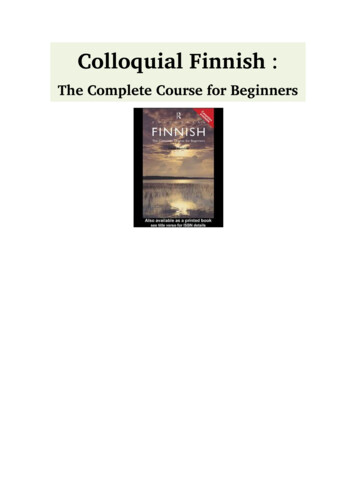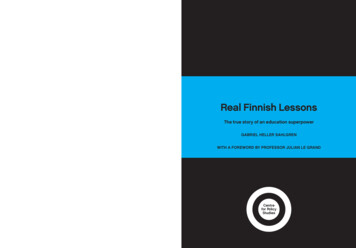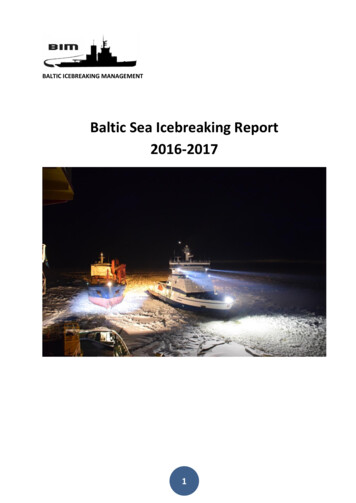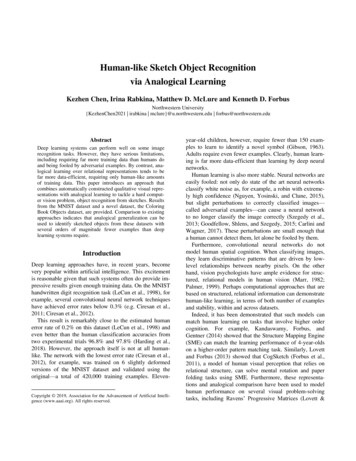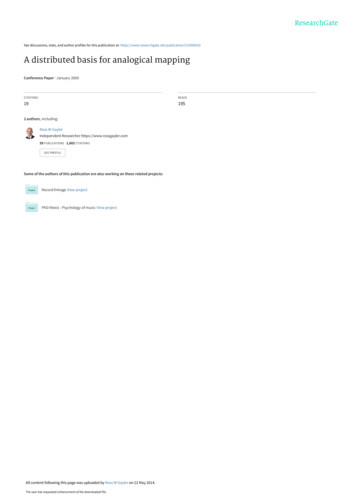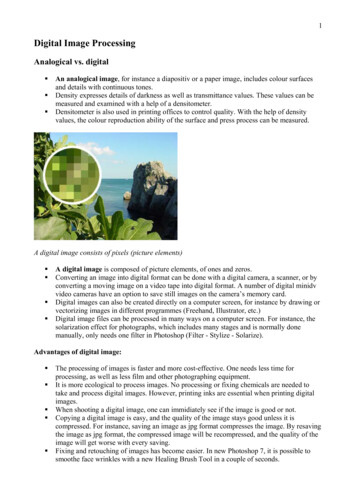
Transcription
1Digital Image ProcessingAnalogical vs. digital An analogical image, for instance a diapositiv or a paper image, includes colour surfacesand details with continuous tones.Density expresses details of darkness as well as transmittance values. These values can bemeasured and examined with a help of a densitometer.Densitometer is also used in printing offices to control quality. With the help of densityvalues, the colour reproduction ability of the surface and press process can be measured.A digital image consists of pixels (picture elements) A digital image is composed of picture elements, of ones and zeros.Converting an image into digital format can be done with a digital camera, a scanner, or byconverting a moving image on a video tape into digital format. A number of digital minidvvideo cameras have an option to save still images on the camera’s memory card.Digital images can also be created directly on a computer screen, for instance by drawing orvectorizing images in different programmes (Freehand, Illustrator, etc.)Digital image files can be processed in many ways on a computer screen. For instance, thesolarization effect for photographs, which includes many stages and is normally donemanually, only needs one filter in Photoshop (Filter - Stylize - Solarize).Advantages of digital image: The processing of images is faster and more cost-effective. One needs less time forprocessing, as well as less film and other photographing equipment.It is more ecological to process images. No processing or fixing chemicals are needed totake and process digital images. However, printing inks are essential when printing digitalimages.When shooting a digital image, one can immidiately see if the image is good or not.Copying a digital image is easy, and the quality of the image stays good unless it iscompressed. For instance, saving an image as jpg format compresses the image. By resavingthe image as jpg format, the compressed image will be recompressed, and the quality of theimage will get worse with every saving.Fixing and retouching of images has become easier. In new Photoshop 7, it is possible tosmoothe face wrinkles with a new Healing Brush Tool in a couple of seconds.
2 The expensive reproduction (compared with rastering the image with a repro camera) isfaster and cheaper.By changing the image format and resolution, the image can be used in a number of media.Disadvantages of digital image: Misuse of copyright is now easier than it earlier was. For instance, images can be copiedfrom the Internet just by clicking the mouse a couple of times.The value of the image will get worse? This has not necessarily happened everywhere.Images held in image banks still have reasonably good prices, inspite of the fact thatdownloading images through the net is fast and easy. The profitableness of digitalphotography has increased the number of images and photography in general.Old professions (such as maker-up, repro cameraman) vanish, and new ones do notnecessarily appear. For instance in mid-1990s, the newspaper Aamulehti started usingcomputerised make-up, and the traditional makers-up were left unemployed.Work has become more technical, which may not be a disadvantage for everyone.A digital file of a certain size cannot be enlargened with a good quality anymore. Forinstance, a good poster cannot be made of an image file of 500 kb. However, it is easy tomake an image smaller.OriginalsThe originals are usually divided into two groups: reflectives and transparences.Reflectives are, for instance(flatbed and drum scanners) drawings, illustrations, graphic drafts, etc. printouts and photos printed materials (When a printed image is being scanned, often a so called moiré-effectoccurs in the new image, which means that the raster angle of the original image is visible inthe new image. One can try to prevent the moiré effect by having the image at a differentangle in the scanner or by using a digital image processing program.Transparences are, for instance(drum and dia scanners) diapositives and negatives other graphic film materialIt is not recommended to enlargen a film negative with more than 800 per cent, since the grain sizewill become too large and the image will become unsharp. In posters and larger advertisements, it iscommon to use a large format dia or save the image in a digital form. In this way the image willmaintain its sharpness inspite of the enlargement.Standard formats and their usage 1/4 basic image 384 x 256 pixels, media use and low-res image in the printed matterbasic image 768 x 512 pixels, digital display and tv screen. In PAL-system a tv screen has720 x 576 pixels.4 x basic image 1536 x 1024 pixels, printed matter (postcard, etc.) and media use.16 x basic image 3072 x 2084 pixels, printed matter (A4) (high-res)
3Sources of digital images:Scanners Drum scanner. Best image quality, for demanding and large printed matters (posters, etc.),exactness of as much as 8000 ppi (pixels per inch), 8-14 -bit colour. Drum scanners aremainly used for reproduction in printing offices and in advertising agencies.Dia scanners. Image of good quality, resolution of 300-3000 ppi, 12-bit colour.Flatbed scanners. Relatively modest quality, resolution of 200-1200 ppi, 8-bit colour depth.Flatbed scanners are inexpensive also for ordinary consumers. Well suitable for small-scaleimage printouts and printing matters, as well as for images shown on the screen.Digital camerasThe shooting resolution of digital cameras continues to get higher as new models are beingdeveloped. Professional cameras, advertisement and product pictures (at least 6.9 million pixels).Professionals also favour digital backs that can be attached to old studio and bulk cameras.Basic cameras of good quality, for print and media use (at least 5 million pixels)Pocket-sized amateur cameras that can nowadays have as much as 4 to 5 million pixels,although 2 to 3 million pixels is the standard. The use of pocket-sized digital cameras willincrease from what it is today. It has been estimated that by the end of year 2003, a total of 5to 10 per cent of all cameras in Finland will be digital cameras (source: Mikropc:nDigikuvaajan opas).The problems of digital cameras have been different types of saving formats, small shootingresolution and high prices for memory cards. For instance, Canon cameras have mainly usedCompactFlash memory cards. The largest cards are as large as one gigabyte, i.e. plenty of picturesfit in one card. However, the number of pictures also depends on the shooting resolution. Cardprices have sunk during the last couple of years, but only some years ago a card of 128 megabytescost around 1000 FIM. At the moment (October 2003) a card of 512 megabytes costs around 160 .In Olympus cameras, a SmartMedia memory card is commonly used. Different saving formatsdemand their own card readers. With the help of a reader, a memory card functions like any disc,i.e. it is easy to transfer images from the card to the computer.Quality criteria of scanners and digital cameras include a good ability to distinguish different tones,as well as adequate sharpness and stability of use. Also a good objective is important in digitalcameras.Other sourcesDrawing programs In most image processing programs it is possible to draw with different drawing tools (penor brush tools, etc.)
4 Vector based drawing programs are, for instance, Illustrator (Adobe) and Freehand(Macromedia). Also Flash-program can be used to make drawings, although the program isdesigned especially for Internet animations.It is easier to draw on the screen with a pressure-sensitive drawing tablet than with a mouse.Animation programs For instance Flash and different gif-animation programs.Flash program can be used to draw vector graphics, and it is possible to bring single screensfrom animations to the image processing program.3D programs For instance, 3D Studio Max, Bryce, AutoCAD, Maya.Used, for instance, in space design, product design, arts, animations, and games.With a 3D program, objects can be animated and 3-dimensional illusions can be createdwith the help of lightingAn image produced by a 3D program can be edited in an image processing program orimages can be attached to Flash program or equivalent.Programs are often expensive and difficult to use.Digital videos It is possible to copy still images from digital videos. Image resolution is high enough toshow images on a computer screen or on tv screen, but not on printed media.Copying images from the Internet Click on the image with right mouse button and choose Save Image As to save the image onyour own computer.Images are easy to save, but the copyright law is valid also for them.It is possible to add a digital identification for images, so that their use is easy to follow upand to find out if they are, for instance, published in the Internet without permissionImages that can be used freely are often of bad quality and too much compressed.Copying from the screen (screenshot) It is possible to copy windows from other programs, or even complete web pages (PrintScreen)Images from a photography shop directly to a CD Rom or to an image gallery in the Internet CD Roms are handy for preserving and filing material.Photography shops’ pictures in the web are normally available only for a certain period oftime.Scanning is sometimes done carelessly and the image resolution is often inadequate forprinted matters.There can be colour errors in web pictures, for instance all images can be greenish.Photographic agency
5 Pictures can be bought on a CD Rom from photographic agencies either one by one, orgrouped in themes. Royalty free pictures are relatively inexpensive, but they can normallynot be used for commercial purposes.Photopraphic agencies on the web: Lehtikuva (http://www.lehtikuva.fi/), Compad(http://www.compad.fi/), and Magnum (http://www.magnumphotos.com/)Copying pictures from the Internet or by using screenshot often violates the copyright law. Apermission from the copywriter is always needed to use pictures.ResolutionThe concept resolution is used in three different connections: 1) in scanning, 2) in pictures, and 3)on screen.1) Scanning resolution (ppi / dpi) In principle, the scanning resolution means the same as the image resolution. Images can,however, be scanned with a higher resolution than necessary in order to edit the imagesmore easily. Image resolution can later be changed in an image processing program.ppi pixels per inch or dpi dots per inchThe unit means the number of pixels in relation to a certain measure, normally an inch.The scanning resolution of an image is determined by the intended use of the image. Forinstance, an image shown on the web only requires 72 dpi, but it does not necessarily makesense to scan it directly to this resolution. If the picture needs editing on screen, it is smart tochoose resolution 150 ppi.2) Image resolution (ppi / dpi) A suitable standard for the screen resolution of an image is 72 ppi.In printed matters the resolution is often 300 ppi. When printing on a newspaper, aresolution of 180 ppi is enough.The bigger the resolution is, the more details the image has, and the larger the file size gets.The file size of a web picture is set to be as small as possible by optimizing the picture, i.e.by choosing the right image format (normally gif or jpg), and by compressing the imageenough, but not too much.The unit for screen images is a pixel (or a dot), in printed matters a millimeter or acentimeter.3) Screen resolution For instance, a recommended resolution for a 17 inch screen is 1024 x 768 pixels, and themaximum is 1280 x 1024 pixels.If too high a resolution is used, it makes the characters unsharp and strains one’s eyes.Particularly when it comes to detailed image processing, too big a resolution is not suitableat all.Bit map graphicsGeneral
6 A bit map image is a chart formed by pixels (or dots), where one pixel equals one squareimage element.In a 1-bit black and white image, a pixel can either be black or white.In a 24-bit full colour image, a pixel can have any of 16.7 million colours.The number of colours makes the image’s file size bigger, but compression can be used tomake the file size smaller again.1-bit imageImage’s bit depth and information The image’s size is the total number of pixels (width times height), for instance 640 x 480 307 200 or 800 x 600 480 000.The bigger the number of pixels (density) is, the sharper the image gets.The bit depth of an image reveals how many tones the image has.1 bit 2 tones2 bit 4 tones4 bit 16 tones8 bit 256 tones, etc.A 24-bit RGB image is formed out of three 8-bit channels, each of which has 256 tones (256x 256 x 256 16.7 million tones)Size of the image filewidth (pix) x height (pix) x bit depth / 8 size of an image file in bytesExample.300 (pix) x 400 (pix) x 24 / 8 360000 in other words 360 kb (kilo bytes)800 (pix) x 600 (pix) x 24 / 8 1 440 000 kb in other words 1,44 Mb (Mega bytes)Interpolation When the resolution of an image is changed, or the image is rotated or scaled, one will haveto interpolate the image in an image processing program, i.e. reorganise the pixels.Algorhytm examines the surrounding pixels and re-evaluates them. Photoshop has thefollowing algorhytms to choose from: bicubic, bilinear, nearest neighbourhood.In Photoshop: Image size Resample ImageMain types of digital imageLine-art, bitmap An image element consists of 1 bit; 1 white and 0 black.
7 Suitable for the presentation of drawings, for instance, drawing ink works, black and whiteline graphics, and texts.Requires little saving space due to the lack of colours, but requires high resolution in orderto show details accurately.Grayscale image The image has 8 bits and 256 tones of grey; 1 black and 255 white.Requires 8 times more saving space than a line-art image.Suitable for presenting black and white photographs, for instance.Can be used in printing office.Colour image (RGB, CMYK) An RGB image has a 24-bit information (millions of colours)Channels Red, Green and Blue have 256 colours each.For screen images. A CMYK image has a 32-bit informationChannels Cyan, Magenta, Yellow, and Black have 256 colours each.For images used in printing offices.Indexed colour 8-bit image information. Availability of 256 colours.Suits well for coloured drawing graphics, but not for photographs.For screen images.Graphics and coloursRGB colour modelCMYK colour modelRGB and CMYK colour systems function in opposite ways. When all printing inks aresuperimposed in the press, the result will be black colour. However, when the highest values of theRGB colour system are put together on the screen, the result will be pure white.RGB
8Light is formed of three primary colours: red, green, and blue. RGB is an additive colour system forlight. The more colours there are, the paler the colour becomes. Each colour (red, green and blue)has 256 different hues (0-255).The functioning of a computer monitor, tv, or other appliance that mediates or filters light, is basedon this colour system. RGB colours function in an opposite way of an eye. They (create and) reflectred, green and blue light.This colour system is used with image processing on the screen, for instance in the Internet, CDRoms, and on tv.CMYK (process colours)CMYK is a subtractive colour system. When light hits an object, it absorbs some of the light andreflects the rest. The reflecting light is the colour that we see.The colour system that is used in printed matters.When syan, magenta and yellow colours are superimposed, the result should be a pure black colour.In reality, the result will be grey or brownish, due to the fact that there are impurities in printinginks syan, magenta and yellow. This has been corrected by adding black printing ink (Key).Due to the fact that CMYK colours are pressed one at a time, layer by layer, printing inks have to betransparent, and opaque colours are being used only in exceptional cases.Cyan and blackMagenta and blackYellow and blackBlack
9All CMYK coloursHSB (hue, saturation, brightness)Hue is a pure colour that is one of the rainbow colours.Saturation indicates the pureness of colour. If the saturation value is 0, the colour is gray. White,black and gray colours have no saturation.Brightness indicates the lightness and darkness scale. If the brightness value is 0, the colour isblack.Vector graphics The exactness and sharpness of vector graphics is based on the utilization of mathematiccurves (so called Bezier curves). Vector image can be zoomed infinitely, but the result isstill always sharp.It is easy to edit an image with the help of curves.Vector-based drawing was originally designed for CAD applications.It is also called element graphics or object-oriented graphics.
10A Bezier curve – forms can be changed after drawingUsage of vector graphics PostersGraphics, where clear contrasts and colour surfaces have been used.Business graphics that can be used in different media, in different sizes and screenresolutions.Logos and text effects that require sharp and even borders. Fonts can be converted intovector paths and then re-edited.Broschures and advertising leaflets, which can include pictures, logos, and text.Spatial design (architecture), product design or other line drawings.With Flash it is possible to make impressive, but light vector graphics and animations forthe web.Advantages and disadvantages Files are small in size.It is possible to enlargen graphics, logos and font without worsening the quality of the image(cf. pixel graphics).The scaling of vector graphics requires fast counting capacity of the computer, becausevectoring is based on mathematical values.Skanning with a flatbed scannerScanners include a program for the actual scanning of a picture. With the scanner program, one canchoose the type of original, for instance a colour picture, black and white picture, colour drawing,black and white drawing, etc. With the program, one can also adjust the contrast and intensity,rotate the picture, or change it to a negative. However, it is not recommended to do the fineadjustments and after-treatment before entering the image processing program, because there it iseasier to cancel functions if necessary. When a cropped picture has been scanned, it cannot beenlargened anymore, but the picture will have to be rescanned.Scanner can also be used directly in an image processing program. For instance in Photoshopchoose File Import Twain.
11Choosing the scanning resolutionThe scanning resolution of an image is determined by the prospective use. An image only shown onthe web, for instance, will not need more than 72 dpi, but it may not necessarily be smart to scan itdirectly to this resolution. It is considerably easier to edit and crop images with a bigger resolution.After processing it is easy to make an image smaller and optimize it to the right format.When choosing the scanning resolution, it is also relevant to know whether the picture will be madebigger or smaller. If the picture needs to be 200 per cent larger than the original, it has to be scannedwith at least twice the original resolution.Scanning1. Place the original image in the flatbed scanner the picture side facing down.2. Open the image processing program and select File Import Twain, or an equivalent function.3. Select Preview, and the scanner will take a quick pass of the image and display a rough versionof it. Select the area you want to scan leave some white edge around the image to make sure thatthe whole image will be saved.4. Select the type of the original, for instance, Colour (photo) and the scanning resolution. It isworth scanning the images for the web with a slightly bigger resolution than necessary (for instance150 dpi), especially if the image needs to be edited. After editing, change the resolution smaller tooptimize it for the net (72 dpi).5. If the colour/hues of the image need to be fixed and the program has suitable adjustingpossibilities, do the needed measures (contrast, brightness, colour balance, colour depth, etc). But ifthe image looks reasonably good, it is better to do the adjustments in the image processing program.6. Select Scan and save the image in a desired place in tif-format, for instance. You can later changethe format and optimize the picture depending on how it will be used.Choosing the printing resolutionPrinterImage resolution (dpi)Image for the web or for the screen72 – 75Black and white laser printer100 – 150Newspaper150 - 180Colour laser150 -180Inkjet printer (600 dpi)180 - 200Inkjet printer (1200 dpi)250 - 300Four-colour printing300 or more.If you print on your own printer, it is worth trying also lower resolutions than the above mentioned
12list recommends. Also printing paper affects the printing quality.The best way to compare different options is to print out the same image with different resolutions.Note also that the enlargening or downsizing of an image changes the resolution.If the resolution of a scanned image is, for instance 200 dpi, and the image is enlargened by 200 percent, the resolution will then be 100 dpi. When downsizing the image, the effect is naturally theopposite.Scanning of textWhen scanning text with a scanner program, it will usually become an image, which cannot befurther edited in a text processing program. If a text is edited in a text recognition program (OCRprograms Optical Character Recognition), it can be saved, depending on the program, in a formthat is recognisable by different text processing programs.If the text recognition program does not have a spelling checker in itself, the first thing to do in thetext recognition program is to use a proof reading program to check if there are errors (the better thetext quality, the less errors), and then to start the actual text processing.The text recognition program does not actually recognise text/words, but characters, which also canbe taught to the program. Problems with recognition may occur with the dots in Nordic characters,and if the text quality is bad.Scanning of text without the OCR program1. Place the picture on the flatbed scanner, picture facing down. (check that the picture isstraight)2. Select Drawing as the scanning type3. Select resolution 300 dpi.4. Preview the image and crop the area to be saved.5. Select Save command and the desired file format.Scanning of text with the OCR program1. Place the picture on the flatbed scanner, picture facing down (check that the picture isstraight).2. Scan the text.3. Read the text with the OCR program and save the text.4. If the OCR program does not have a spelling checker, do the proof reading and editing inthe text processing program.Screen resolution
13The size of the screen is affected by the physical size of the screen (for instance 17 inches), theresolution rate, as well as the graphic adapter. The graphic adapter forms the picture on the screen.Sharpness of the ScreenAll resolutions cannot be used on screens of all sizes, but it is recommended to use a certainresolution on a certain screen. The table includes normative resolutions for the most commonscreens.Screen sizeOptimalMaximum15"800 x 6001024 x 76817 "1024 x 7681280 x 102419"1280 x 10241600 x 1200Using a too high resolution will make the characters on the screen confused and strains one’s eyes.Especially with detailed image processing, too big a resolution is not suitable at all.The quality of the screen is also affected by the updating frequency, which expresses how manytimes per second the picture on the screen is being updated. If the frequency is too low, the screenwill flicker. Also the graphic adapter affects the choice of frequency. The recommended minimumupdating frequency is 72 Hz. Both the resolution and updating frequency can be changed throughthe Windows Control panel (Screen icon).Number of screen coloursWhen forming colours, a computer screen uses three primary colours: red, green and blue, i.e. thepreviously mentioned RGB colour system.Screen resolution and web pagesThe biggest problem with web design is that different users have screens of different sizes andquality. How should a web page be designed to work well with different screen resolutions?During years 1995-1997 most of the screens had size 14 or 15 inches, and the resolution usuallywas 640 x 480 or 800 x 600 pixels. Usually the smallest resolution users may have, which in thiscase was 640 x 480 pixels, has to be taken into consideration. Although 17 and 19 inch screens havebecome more popular since the year 2000, web pages are still usually designed for resolution 800 x600. The resolution problem can be solved by defining the tables, frames, and other elements on thepage in relation to each other, i.e. in per cents, and not in pixels. With relative definitions the page isscaled to fit the screen. However, it is difficult to create impressive and carefully finished layouts,because the pictures, texts, and other elements on a scaling page move in different ways on differentscreens.The same problem occurs also in image design. If a photographer wants to have a photo on thescreen and wants it to fill half of the screen, it turns out to be an impossible task. On a screen sized800 x 600, the picture would be 400 x 300 pixels. But all screens do not have the same setups.Image and page design for the web is full of compromises.Compare the examples of an identical picture on two different screen resolutions:
14A picture of 800 x 600 pixels on a screen with resolution 1152 x 864.
15A picture of 800 x 600 pixels on a screen with resolution 1600 x 1200.Most common image formatsFormats designed for different programs have increased the total number of file formats. Only veryfew programs support more than 10 formats. Pictures saved with a new program version do notnecessarily open in an older program version, although the old version supports the file format inquestion.raw A standard bit map format between different programs and computer systems.Used as a format for cell phone logos, for instance.Supports most colour formats (RGB, CMYK, grayscale, etc.)bmp Bit map formatA standard for bit map images developed by Microsoft and IBMOnly functions in IBM compatible PC computers.Common in Windows systems.tiff - printed matters Tagged Image File Format has been developed together with the Aldus scanner technique,andis one of the eldest commonly known file formats.There are at least three versions of the Tif-format (4.2, 5.0 and 6.0).Can utilize the effective LZW compression.A common saving format for scanning, because Tif images usually open in programssupporting this format.Image can be saved in RGB or CMYK formatsPCs and Macs use different bit formatseps - printed matters Encapsulated PostScriptBoth vector and pixel images can be saved in this file formatThe file consists of a printing and a screen module.File sizes can be large.jpeg - web .jpg or .jpegJoint Photographic Expert Group.An image compressing file format which suits well for photographs on the web.The way of compressing does not limit the number of colours, i.e. millions of colours areavailable.An image can be compressed as much as to 1/100 of the original.Browsers support this format without plug-in.
16 Compressing merges pixels to hues that are most similar to them, but does not change theintensity.This way of compressing destroys information, and therefore resaving must be avoided.Compressing the image too much makes it confused.Well suitable as the web format of photographs.gif - web Graphics Interchange FormatA file format for transferring images, developed by CompuServe.Availability of max. 256 colours.Functions best for drawings, logos, coloured graphics and icons, but not for photographs.Browsers support this format without plug-in.Supports Interlacing technique. An image on the screen is first coarse and gradually getssharper.Can be animated (gif animations).Supports only Indexed ColourDesired colours can be turned transparent, as a result of which graphics can be embedded onthe web page without unpleasant borders.Suitable for drawings and other web graphics.psd - PhotoShop’s working file for additional editing and for saving the master Adobe Photoshop’s own file format.Saves information, for instance, of the used colours and layers.File sizes can become large if many layers have been used in image processing.A psd file saved in PC can be opened in Mac.The format of a psd image is eventually changed according to its intended use, for instance atif format or an eps format is used in printing offices.png - web Portable Network GraphicsSupports the Interlace and Background transparency functions.Includes an alpha channel.Can have as much as 48-bit colours, in which case image files can become very large.Compressing method does not destroy information.Compresses image 10 to 30 per cent more effectively than gif.Does not function in Netscape or Explorer –browsers without plug-in. For this reason theformat has not gained more popularity.pdf - web or printing office Portable Document File is a PostScript-based format for transferring, viewing and printing,and is not dependent on the operation system.May include vector graphics and bit map images.It is possible to embed fonts.May include active links.Requires Acrobat Reader for reading, and Distiller for making changes.Saving images on the web
17It is recommendable to save a duplicate copy of the completed image. One often has to revert to theimage and do some minor changes to it. The master should be saved in PhotoShop’s own psdformat so that all layers, alpha channels and other elements are kept unchanged.When saving the image (and naturally already when starting the work), one has to be aware ofwhere the image will be used. If the image wil
A digital image is composed of picture elements, of ones and zeros. Converting an image into digital format can be done with a digital camera, a scanner, or by . diapositives and negatives other graphic film material It is not recommended to enlargen a film negative with more than 800 per cent, since the grain size .



